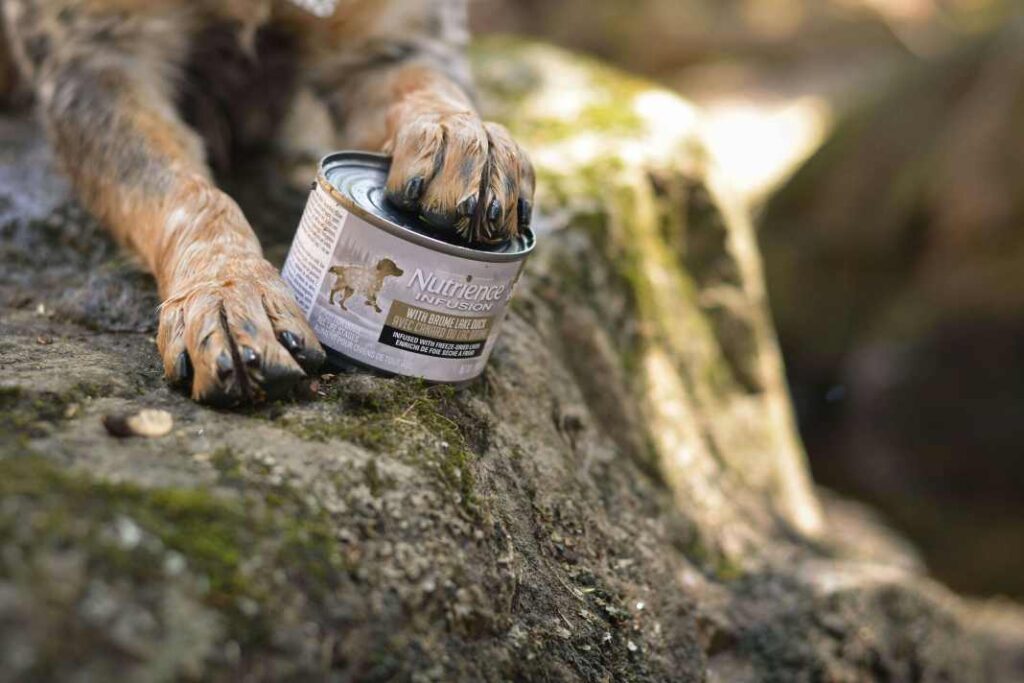When my neighbor left me a voice message asking me how long can dogs go without eating, I spent a sleepless night thinking about how crazy that question seemed.
I knew he was planning a weekend fishing trip, and wondered if he was planning to leave his dog home alone, and a bunch of other horrifying scenarios. Fortunately, the reason for the question was relatively harmless, and more of concern for his dogs current loss of appetite.
However, his question did give me reason to think it worthy writing about. So here we go…
Dogs can exhibit varying behaviors when it comes to eating, often influenced by their health, age, and environment. Most healthy dogs can go without food for about three to five days, but this time frame can differ based on individual circumstances. Understanding these factors is crucial for any dog owner who may encounter a situation where their pet refuses food.
For some dogs, a temporary loss of appetite may be due to stress, dietary changes, or minor health issues – as was the case with my neighbors dog. However, a persistent lack of interest in food could signal a more severe problem that warrants attention. Recognizing the signs and knowing when to seek veterinary advice is essential for maintaining a pet’s well-being.
Exploring the reasons behind a dog’s refusal to eat, as well as the implications of short-term fasting, can provide valuable insights. This knowledge empowers dog owners to make informed decisions and ensure their pets remain healthy and happy.
Understanding Canine Nutrition and Fasting
Proper nutrition is crucial for a dog’s health and well-being. Understanding what constitutes a balanced diet and the effects of fasting can guide pet owners in making informed decisions regarding their dog’s feeding habits.
Essential Nutrients for Dogs
Dogs require a balanced diet that includes proteins, fats, carbohydrates, vitamins, and minerals.
- Proteins are essential for building and repairing tissues. Sources include meat, fish, and legumes.
- Fats provide energy and support cell function, often supplied through meats and fish oils.
- Carbohydrates offer a quick energy source, found in grains and vegetables.
Additionally, vitamins and minerals play vital roles in metabolism, immune function, and bone health. A varied diet ensures that dogs receive all necessary nutrients to maintain their energy levels and optimal health.
Normal Feeding Patterns
Dogs typically thrive on a routine feeding schedule. Most adult dogs eat one to two meals per day, while puppies may require three to four smaller meals.
Consistency in feeding times helps maintain a dog’s appetite and digestive health. The amount of food depends on factors like age, breed, size, and activity level. Regular monitoring of a dog’s weight and overall condition can help determine if adjustments in diet are necessary.
What Happens When Dogs Don’t Eat
When dogs stop eating, several physiological changes can occur. Initially, a dog may exhibit a decrease in energy levels and changes in appetite. Lack of food impacts various aspects of health, including:
- Stomach health: Prolonged fasting can lead to gas, nausea, or gastrointestinal issues.
- Nutrient deficiencies: Extended lack of food may lead to deficiencies in vital nutrients, affecting the immune system and overall health.
It’s crucial for owners to monitor their dog’s behavior when food intake decreases. Extended periods without eating may necessitate veterinary intervention to address underlying health concerns.
Factors Affecting a Dog’s Appetite
Several factors can influence a dog’s desire to eat. Understanding these can help owners identify potential issues and take appropriate action.
Behavioral Reasons for Not Eating
Behavioral issues can significantly impact a dog’s appetite. Stress and anxiety are common reasons; environmental changes, loud noises, or the presence of unfamiliar people can all trigger fear responses. These reactions can lead to a temporary loss of interest in food.
A dog’s daily routine also affects eating. For example, changes in schedule or a lack of exercise can lead to decreased appetite. Additionally, boredom with regular food may cause them to refuse meals, so variety in their diet can help maintain interest.
Understanding the dog’s behavior during feeding times can provide insights into their appetite levels. Observing whether they eat alone or prefer companionship can also help owners address these behavioral factors.
Health-Related Causes of Appetite Loss
Health issues are another significant factor in a dog’s appetite. Illnesses such as nausea, vomiting, or diarrhea can lead to decreased food intake. When a dog feels unwell, its natural response is to avoid food, which can be concerning for owners.
Pain is another critical factor. Conditions like dental problems, arthritis, or injuries can make eating uncomfortable. If a dog shows signs of pain while eating, a veterinary check-up is advisable.
Certain medications may also reduce appetite. Some treatments have side effects that include nausea or gastrointestinal upset, further complicating a dog’s eating habits. Monitoring the dog’s overall health is essential in identifying whether appetite loss is a symptom of a more serious condition.
Identifying and Assessing Symptoms
Recognizing symptoms in dogs that haven’t eaten for an extended period is crucial. Certain signs may indicate serious health issues that require immediate attention.
Recognizing Signs of Serious Health Issues
A loss of appetite lasting more than 24 hours can signal potential health concerns. Symptoms such as vomiting or diarrhea accompanying this condition should not be overlooked. These could indicate gastrointestinal problems or infections.
Additionally, lethargy is a critical sign. If a dog appears unusually tired or unresponsive, it may be suffering from dehydration or underlying illness.
Older dogs or those that are typically picky eaters might also show different behaviors when unwell. Close observation is key, as any sudden changes in behavior or physical condition warrant further investigation.
Signs of dehydration such as dry gums, excessive thirst, or infrequent urination should prompt immediate action. These can severely affect a dog’s health.
When To Consult a Veterinarian
A veterinary visit is essential if a dog has not eaten for more than two days or shows signs of distress. Early intervention can prevent further complications.
During the visit, a physical exam will assess the dog’s overall condition. The veterinarian may recommend diagnostic tests to determine the underlying cause of the appetite loss.
If symptoms like vomiting or diarrhea are persistent, seeking veterinary advice becomes critical. Prompt action can guide appropriate treatment, addressing not just the immediate issue but also any underlying health concerns.
In instances where the dog is a senior, special considerations apply, making it even more important to consult a vet early.
Examining the Dangers of Extended Fasting
Extended fasting in dogs poses serious health risks that can escalate quickly. Understanding the differences between short-term and long-term fasting is crucial for dog owners to recognize potential complications.
Short-term vs. Long-term Fasting
Short-term fasting, typically lasting one to two days, can be manageable for most dogs. They may experience mild discomfort, but their bodies can often cope without immediate harm. It is essential to ensure that they have access to fresh water to prevent dehydration.
Long-term fasting, exceeding three days, can lead to severe issues. Prolonged periods without food can result in significant weight loss and nutritional deficiencies. Organ failure is a critical risk as the body begins to shut down its non-essential functions. An ill dog may exhibit lethargy, vomiting, or diarrhea.
Potential Complications from Not Eating
When a dog does not eat, several complications can arise. Dehydration is a primary concern. Without food, a dog’s water intake may decrease, potentially leading to serious renal issues.
Illness can exacerbate problems if a dog is already taking medications. The lack of food can affect the absorption of these medications, impacting their effectiveness. Furthermore, vomiting and diarrhea can lead to further dehydration and a medical emergency if left untreated.
In severe cases, the animal’s survival may be at risk, necessitating immediate veterinary attention. Recognizing these symptoms early can make a significant difference in a dog’s health and recovery.
Dealing with a Dog Not Eating
Addressing a dog’s refusal to eat requires a thoughtful approach that considers immediate actions, careful food transitions, and strategies to enhance appetite. It is important to assess the situation without causing additional stress to the dog.
Immediate Steps to Take
When a dog stops eating, the first step is to observe for any signs of illness or distress. Symptoms such as vomiting, diarrhea, or lethargy may indicate underlying health issues that require veterinary attention.
If a dog has not eaten for more than 24 hours, it is advisable to consult a veterinarian. This is especially important for puppies or older dogs, as they are more vulnerable to complications from inappetence.
Ensuring the feeding schedule is consistent can help create a routine. Offering small, enticing portions at specific times may encourage the dog to eat. Using favored treats or a small amount of wet food mixed with their regular kibble can also stimulate interest.
Transitioning to New Foods Carefully
If a dog is a picky eater, introducing new food should be done gradually. Sudden changes can upset the dog’s stomach and lead to refusal to eat.
Start by mixing a small amount of the new food with the current food. Over several days, increase the proportion of new food while decreasing the old. This slow transition helps the dog adjust to new flavors and textures.
Consider using warm food or flavored water to make the meal more appealing. Heating food in the microwave for a short time can enhance the aroma, making it more enticing. Cooked chicken breast is another option to incorporate, as many dogs enjoy the taste.
Improving Your Dog’s Appetite
To boost a dog’s appetite, offering a variety of foods can be beneficial. Experiment with different textures and flavors, including wet foods or treats that contain meat.
Incorporating small, nutritious snacks throughout the day may help maintain energy levels without overwhelming the dog at meal times. Choosing high-value treats or adding a few bites of chicken can incentivize a reluctant eater.
If medication is causing side effects such as loss of appetite, consulting a veterinarian is essential. They can adjust the dosage or suggest alternatives to improve the dog’s eating habits.
Creating a calm and stress-free environment during meal times can also enhance eating behavior. Reducing noise and distractions allows the dog to focus on the food, which can lead to a more positive experience at mealtime.
Prevention and Maintenance for Healthy Eating Habits
Maintaining healthy eating habits in dogs involves regular check-ups and careful dietary considerations. These practices can help prevent issues such as anorexia, allergies, and other health problems.
Establishing Routine Check-Ups
Routine visits to the veterinarian are essential for monitoring a dog’s health. These check-ups allow for the early detection of parasites, dental problems, or other issues that may affect appetite.
During these visits, the vet can assess the dog’s weight, dental health, and overall condition. They can also tailor feeding schedules based on the dog’s specific needs.
Regular vaccinations are crucial as well, preventing diseases that could lead to decreased food intake or hypoglycemia. Keeping a consistent schedule fosters better eating habits and helps owners notice any changes in their dog’s behavior over time.
Dietary Considerations and Adjustments
Diet plays a significant role in a dog’s eating habits. Owners should provide a balanced diet that meets nutritional needs, avoiding unhealthy human food high in salt and sugar. Incorporating fresh water through a dog water fountain can encourage hydration, promoting overall health.
If a dog shows signs of anorexia or low blood sugar, it’s essential to consult a veterinarian for advice on dietary adjustments. This may include changing food brands or considering allergies to particular ingredients.
Additionally, exercise is vital for maintaining a healthy appetite. Proper activity levels can stimulate a dog’s desire to eat and ensure they receive the right nutrients.
FAQs: How Long Can Dogs Go Without Eating
Many dog owners are concerned about their pet’s eating habits. Understanding how long a dog can go without food and the effects of not eating is essential for ensuring their health and well-being.
How long is it safe for a dog to go without consuming food?
In general, a healthy dog can go without food for about three to five days. Factors such as age, health, and hydration can influence this timeframe.
What are the implications of a dog not eating but still drinking water?
If a dog refuses food but continues to drink water, it may survive longer than without any fluids. However, prolonged lack of food can lead to weight loss and energy depletion.
In cases of illness, how long can a dog survive without eating?
Ill dogs may not sustain themselves without food for as long as healthy dogs. Depending on the condition, they could suffer from serious health complications after just a few days without nutrition.
What should be done if a dog refuses to eat or drink and remains inactive?
If a dog is not eating or drinking and shows signs of inactivity, immediate veterinary attention is necessary. This behavior can indicate serious health issues that require prompt evaluation.
How many days can a dog typically last without any food before health risks increase?
While dogs can last about five days without food, health risks can begin to rise after just two to three days. This includes the potential for liver damage and other metabolic disturbances.
What supportive care can be given to a dog that has lost its appetite?
Supportive care may include offering palatable food options, ensuring access to fresh water, and administering medications as prescribed by a veterinarian. Close monitoring of the dog’s weight and condition is also important.
Meeting the Nutritional Needs of Dogs: A Guide to Age-Appropriate Feeding

Puppies and adult dogs have distinct nutritional requirements to support their growth, development, and overall health. Puppies need diets that are rich in protein, fat, and calories to fuel their rapid growth and energy levels, while adult dogs require specific nutrients to maintain their health and vitality.
Continue reading: Meeting the Nutritional Needs of Dogs
A Comprehensive Guide to Canine Health: Nurturing Your Dogs Well-Being

Continue reading: Nurturing Your Dogs Well-Being




